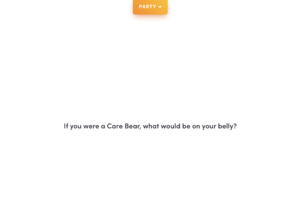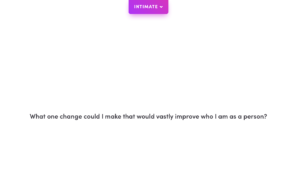For my competitive analysis I want to take a look at the game ‘Truth or Drink’. You can buy this game on cut.com, or play an online version on psycatgames.com. While possibly a different target audience from my group’s game concept, certain mechanics—like selecting cards and answering potentially uncomfortable questions—are similar enough to make for some interesting insights.
Truth or drink is a game where you draw a card that asks an intimate question and you have the choice of either answering that question or drinking.
To add nuance to what is otherwise a very simple process, a clear mechanic emerges that impacts the game more than I would have guessed. Before beginning the game, the players have the choice of selecting cards from differently themed decks. The decks not only change which questions are asked but also have a remarkable impact on the broader theme of the game, as well as the type of fun promised to the player. For instance, if you choose the ‘Party’ deck the questions are funny, social and lively—asking mostly humor-based or experiential questions. Obviously this deck suggests a funny, banterous activity between a group of friends.

The ‘dirty’ mode is similar to the experiential type questions of “Party” but with an obvious lean towards sexually charged questions. I’m not sure if this promises anything all too different from the “Party” deck, other than the exciting possibility of added sexual energy or just added awkwardness. Depends on the group I guess.
Meanwhile, in the ‘Intimate’ deck, I was surprised to find that the questions were just genuinely thoughtful questions asking insights about members of the group. This one mutable property of the  game—selecting the deck—potentially alters the theme of the game from a rowdy hilarious ‘pregame-the-party’ game, to a ‘wine-night-sit-around-and-talk-about-who-we-are-game’. I think this is a strength but can also be a major flaw for marketing this product. Those two games would appeal to potentially very different crowds, and making both audiences know the game is right for them could prove difficult.
game—selecting the deck—potentially alters the theme of the game from a rowdy hilarious ‘pregame-the-party’ game, to a ‘wine-night-sit-around-and-talk-about-who-we-are-game’. I think this is a strength but can also be a major flaw for marketing this product. Those two games would appeal to potentially very different crowds, and making both audiences know the game is right for them could prove difficult.
All taken together, this game should give my team some interesting takeaways. There’s certainly strength with giving the users that level of choice, but it should also help us narrow our focus on what setting we imagine our ideal players to be in. Nailing our desired theme will make the process more exciting for the players and more clear what sort of fun they can expect to have.


